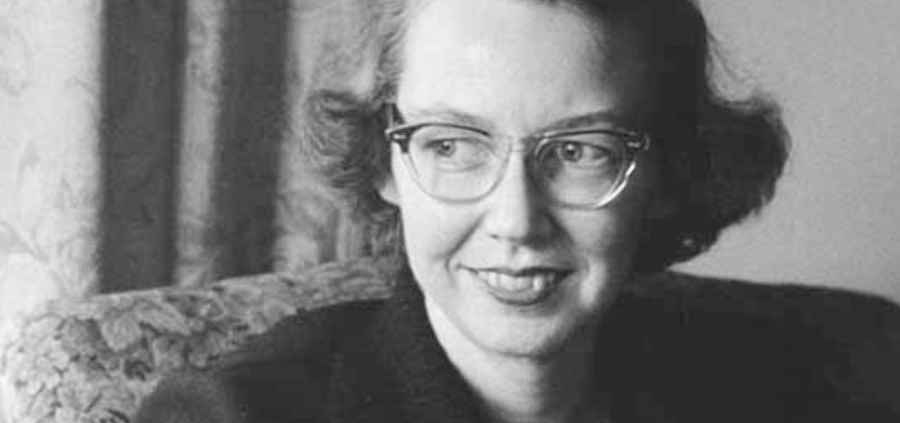Documenting Change by Chris Byrd
Flannery
Written, produced, and directed by Elizabeth Coffman and Mark Bosco
Long Distance Productions
NR 1 hour, 37 minutes
Now streaming online, the richly textured, nuanced, and evocative documentary Flannery highlights a childhood incident which “marked” Flannery O’Connor (1925–1964) “for life.” When the American fiction writer was five, a Pathé News film crew came to her Savannah, Georgia, hometown to document her backward-walking chicken. The newsreel narrator says of the bird, “when she arrives, she’s really leaving.”
That’s a fitting description of the life and career of the Catholic southern woman Flannery profiles. Veteran filmmaker Elizabeth Coffman collaborated with the Jesuit priest and O’Connor expert Mark Bosco to write, produce, and direct the film. Having won the inaugural Library of Congress Lavine/Ken Burns Prize for Film, Flannery will also air on the PBS American Masters series at a later date.
Fordham University professor Angela O’Donnell underscores O’Connor’s fundamental motivation: “to be a faithful Catholic writer” who wrote about “freaks, prophets, misfits, and saints,” as the filmmakers describe her characters. O’Connor’s story “Temple of the Holy Ghost,” for example, displays the author’s Catholic empathy for “freaks.” According to Catholic novelist Mary Gordon, this story about a 12-year-old girl’s fascination with an intersex person at a small-town carnival reflects O’Connor’s belief that “God’s spirit has a dwelling in you.”
When her first novel Wise Blood was published in 1952, O’Connor was diagnosed with the autoimmune disease lupus, which took her life at 39 in 1964. Lupus mostly confined O’Connor to her dairy farm, Andalusia, in Milledgeville, Georgia, southeast of Atlanta. Even in her relative isolation, O’Connor couldn’t avoid her region’s social revolution. She achieved prominence during the peak of the Civil Rights movement and died a month after the Civil Rights Act was passed in 1964.
Flannery is at its most creative, challenging, and interesting discussing O’Connor’s racial attitudes. O’Connor’s fiction keenly records the dramatic change she observes, and satirizes those who resisted it. New Yorker theater critic Hilton Als states that she is a “brilliant reporter about the ways the social order [was] changing. Showing the disruption of the fantasy of whiteness and the fantasy of power.”
O’Connor’s frequent use of racial epithets, however, means that a lot of her stories are judged by modern readers as unacceptable, according to Catholic memoirist Richard Rodriguez. African Americans seeking new freedoms tested the author’s racial ideology. O’Connor once referred to the playwright Maryat Lee as a “Nigger Loving New York White Woman” and famously refused Lee’s invitation to meet storied African American writer and activist James Baldwin in Georgia. (She was happy to meet Baldwin in New York, but observing “the traditions of the society I feed on,” she said, “you might as well expect a mule to fly as me to see James Baldwin in Georgia.”)
The filmmakers admirably try to get her champions to confront O’Connor’s regrettable mindset, but they protect her reputation. The Color Purple author Alice Walker’s views, as an African American, are especially forgiving. “No one should be locked to ideologies they were born into,” she says.
In a July New Yorker article, O’Connor biographer Paul Elie claimed that efforts to contextualize the author’s racist remarks end up patronizing her because they assume she “lacked the free will to think for herself.” Reluctance to face the author’s racist passages “squarely,” Elie believes, “keeps us from approaching her with the seriousness that a great writer deserves.”
They may not elicit forthright responses from O’Connor’s admirers, but the filmmakers’ persistent scrutiny of her contradictions reveals a great writer devout in her faith, heroically facing her own suffering, yet constrained by narrowmindedness. In one of the more unforgettable musical montages you’ll ever see, the filmmakers dramatically suggest the changes O’Connor documented also shook her foundation. Images of lunch-counter protestors are matched with Roy Rogers’s classic “Don’t Fence Me In,” and the song is transformed into a liberation anthem.
Vivid computer animation renders O’Connor’s 50- to 60-year-old stories, which actress Mary Steenburgen’s narration brings freshly alive. Listening to her mellifluous interpretation of O’Connor’s words is one of Flannery’s abiding joys. Making excellent use of rare archival footage and striking candid photos, Flannery will happily intrigue those unfamiliar with O’Connor and her devotees alike, spurring all to delve more into O’Connor’s world.
Chris Byrd writes from Washington, D.C. His work has appeared in America, Sojourners, and the National Catholic Reporter.





Leave a Reply
Want to join the discussion?Feel free to contribute!